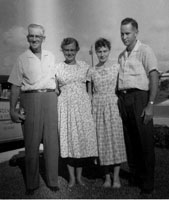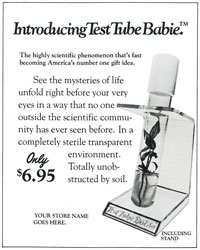12/30/2016
The Making of a TC Pioneer
Chris Beytes

Ray Oglesby started Oglesby Nursery in 1947 in Hollywood, Florida, with his dad, Henry. But this wasn’t the Oglesby you know for tissue culture propagation—there was no tissue culture back then. This Oglesby was a traditional South Florida outdoor ornamental plant nursery, growing landscape material throughout the 1950s, ’60s and ’70s for major projects such as the Julia Tuttle Causeway in Miami.
Henry passed away in 1959. Ray’s mom, Laurentia, continued to live in the family home on the nursery property.
Pictured: Henry and Laurentia with Ray and his wife, Jane, circa 1958.
“They had a very close relationship,” recalls Ray’s daughter, Mary Oglesby McKenzie. “He would check on her every day, took care of her. She loved orchids and mangoes. We had the biggest mango grove anywhere around because every year for a while he’d give her a new mango tree. So we had I think 12 or 15 different varieties of mangoes. He built her an orchid house and he’d help her take care of them.”
Then mom fell ill. She moved to Ray’s home, passing away in 1975 at the age of 69.
“After she passed, he didn’t have much spirit,” recalls Mary. “He went to work every day, but you could tell his heart wasn’t really in it. He got the job done, but … it was a big loss for him.”
To get Ray out of his funk, some of his nursery friends—Bert Kraft (Kraft Gardens), Jerry Soowal (East Marsh Nursery) and Joe Cialone (Tropical Ornamentals), she recalls—talked Ray into making a trip to Lake Placid, New York, to attend a conference on a new-fangled way of propagating plants called tissue culture, led by TC expert Dr. Toshio Murashige of the University of California-Riverside.
Apparently, the diversion worked. Mary says that when he returned from New York, tissue culture was all he talked about. Within a few months, he had set up a 10 x 14 lab in his garage.
However, Ray’s sudden interest in this new method of propagation wasn’t unusual, explains Gary Hennen, long-time president of Oglesby Plant Laboratories and now Oglesby Plants International.
“Ray was very progressive in propagation. And he was very interested in the technology of propagation. He was one of the first South Florida nurserymen to embrace mist propagation, which was a game-changer back then. But when this new science of plant tissue culture came up, it really struck his fancy.
“That was the big game-changer in this company, when he saw tissue culture.”
That garage laboratory started small. Tools were sterilized in Laurentia’s old pressure cookers. Ray’s buddies in the nursery business would bring plants over and ask, “Can you do this, Ray?” Over time, the research became more and more of a business of propagating tropical foliage for himself and his friends, even as the landscape nursery continued.
His first employee was Randy Strode, an Illinois school teacher who took a leave of absence to learn about horticulture (Randy went on to found his own TC lab, Agri-Starts). Their first major commercial crop was a daylily called Aztec Gold. Gary says this selection was fortuitous.
“Anybody in tissue culture who has worked with hemerocallis knows that most of them are very difficult to do; lucky for us, he picked Aztec Gold, which turned out to be easier to propagate. It was very successful.”
That success spurred construction in 1978 of a dedicated facility, credited as the first building in America designed and built specifically as a plant tissue culture lab. At 2,000 sq. ft., it certainly dwarfed the garage lab, but Gary (who joined the company in 1982) says they quickly filled the space, thanks to strong demand for their products, which now included anthurium, spathiphyllum, dieffenbachia, syngonium and more.
Why was tissue culture such a revolution? Before then, these crops were propagated by seed or division, which was slow and also could transmit diseases. Says Gary, “The vegetative propagation of some of these old-line tropical plants like dieffenbachia and syngonium harbored all kinds of nasty diseases. Through the work of the tissue culture laboratories, Oglesby and others at the time, these crops started to be cleaned up. Dieffenbachia viruses and Erwinia problems became a thing of the past for growers who embraced tissue culture.”
The revolution continued, with Ray expanding northward in 1984 to a new facility in Altha, Florida, west of Tallahassee in the Panhandle (where Ray had bought a farm where the family spent summers and holidays). This facility was soon working two shifts to keep up with demand. To make it easier for growers to grow the difficult-to-handle tissue culture plantlets, Oglesby began producing liners in both Altha and Hollywood, which were larger and easier to transplant and grow on. And with Oglesby looked upon as a leader in tropical plant innovation, it was only natural that they would begin breeding their own new varieties.
Eventually, the Hollywood landscape nursery was closed and the business was consolidated in Altha. Ray passed away in 2003, but Gary, Mary and Ray’s son, David Oglesby, continue to drive the business forward, always innovating, as Ray did. Most interestingly, in the last 10 years, Oglesby has branched back into landscape plants and are looking at perennials and other outdoor landscape crops.
“It’s come full circle,” says Gary.
The Birth (and Death) of Test Tube Babie
In 1977, Ray decided to launch a consumer product, a little spathiphyllum in a test tube, which he dubbed “Test Tube Babie” (the spelling was no doubt to avoid any confusion that it was a real baby). He put a lot of work into packaging and advertising, and hired a PR firm to launch it.
 A newspaper piece from the Palm Beach Post from October 1977 reported the launch of the product: “[Test Tube Babie] arrived last week at the K-Mart store at Forest Hill Boulevard and Military Trail—first site in the nation to test market the new product, which sells for $5. “I think it's unique as hell,” said Bob Lucas, general manager of the store. “The Pet Rock does nothing. This grows and it’s a conversation piece.” K-Mart’s promotion also features a T-shirt that proclaims: ‘I am a parent of a Test Tube Babie.’”
A newspaper piece from the Palm Beach Post from October 1977 reported the launch of the product: “[Test Tube Babie] arrived last week at the K-Mart store at Forest Hill Boulevard and Military Trail—first site in the nation to test market the new product, which sells for $5. “I think it's unique as hell,” said Bob Lucas, general manager of the store. “The Pet Rock does nothing. This grows and it’s a conversation piece.” K-Mart’s promotion also features a T-shirt that proclaims: ‘I am a parent of a Test Tube Babie.’”
Unfortunately, Test Tube Babie was somewhat controversial, recalls his daughter Mary. The technology was in its infancy, and the science and morality of animal and even human cloning was being hotly debated.
“Unfortunately, it was a dismal financial failure,” Gary says. When he joined the company in 1982, Test Tube Babie was still alive, but its days were numbered. They pulled the plug on the project that same year. Gary says it wasn’t so much the controversy; it was the more practical aspect of perishability. Retailers tended to display a few and leave the rest in the box in the stockroom.
However, there was a bright side: Ray gained worldwide notoriety for Oglesby’s new tissue culture technology. Says Gary, “He was written up in magazines, newspapers … everybody knew about his new tissue culture and this new laboratory in Hollywood, Florida. So, depending on how you look at the investment, it really brought Oglesby’s laboratory to the forefront and everybody started talking about tissue culture.” GT